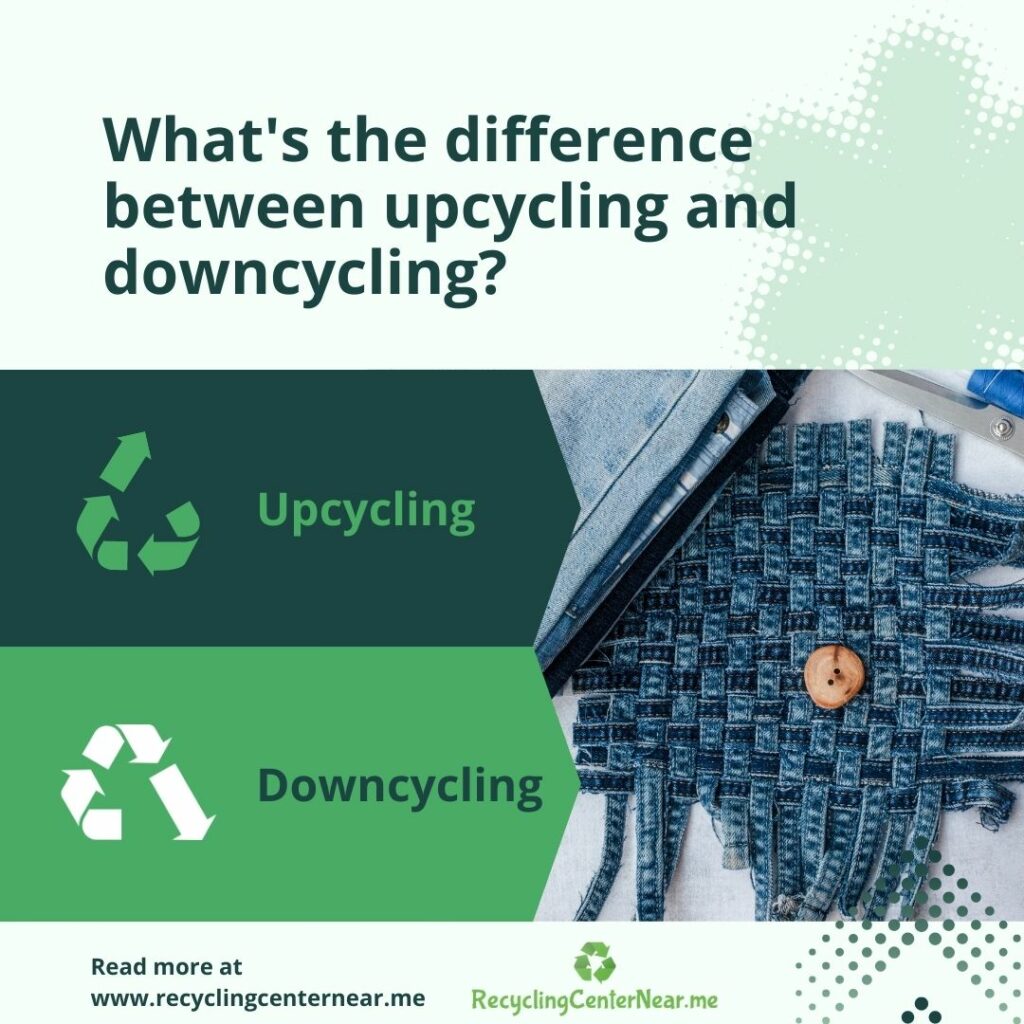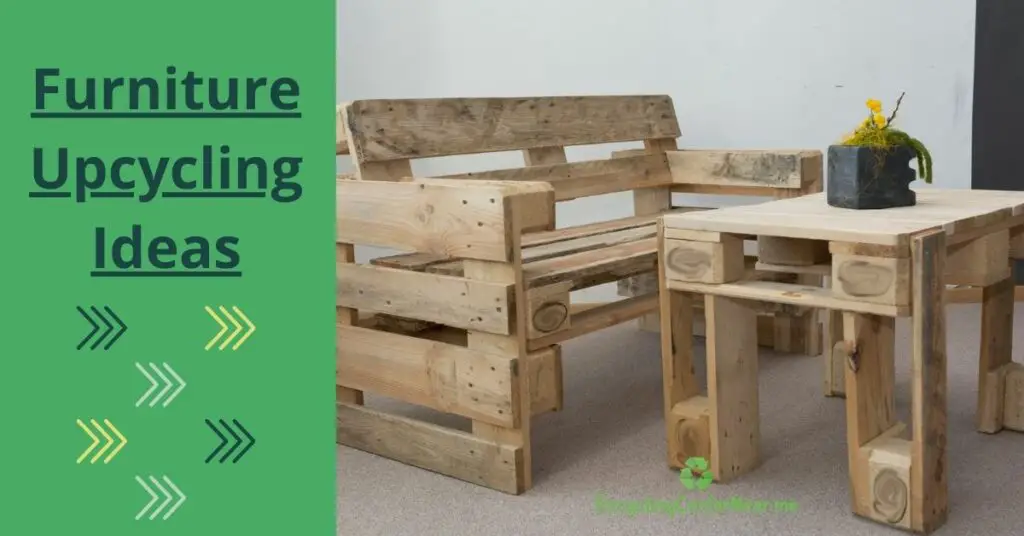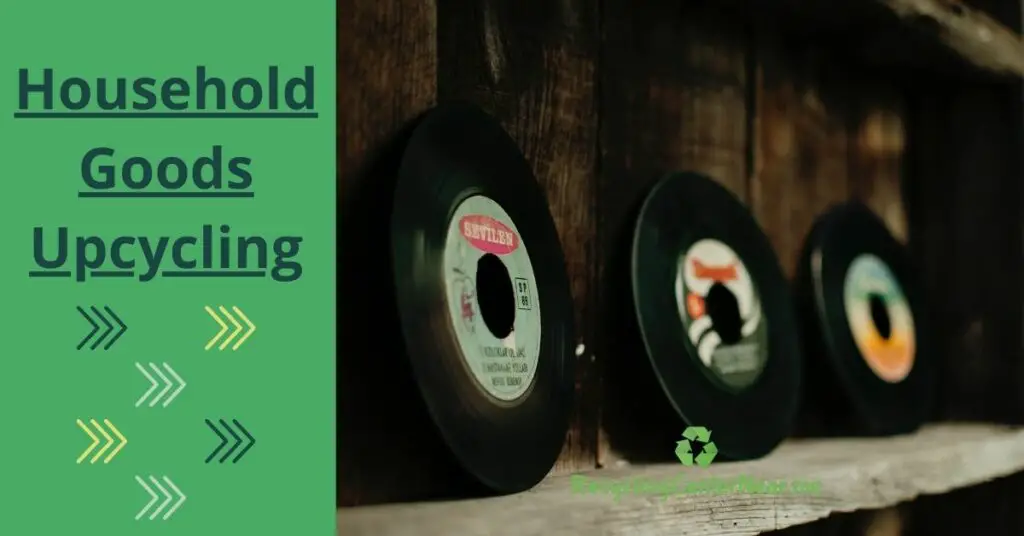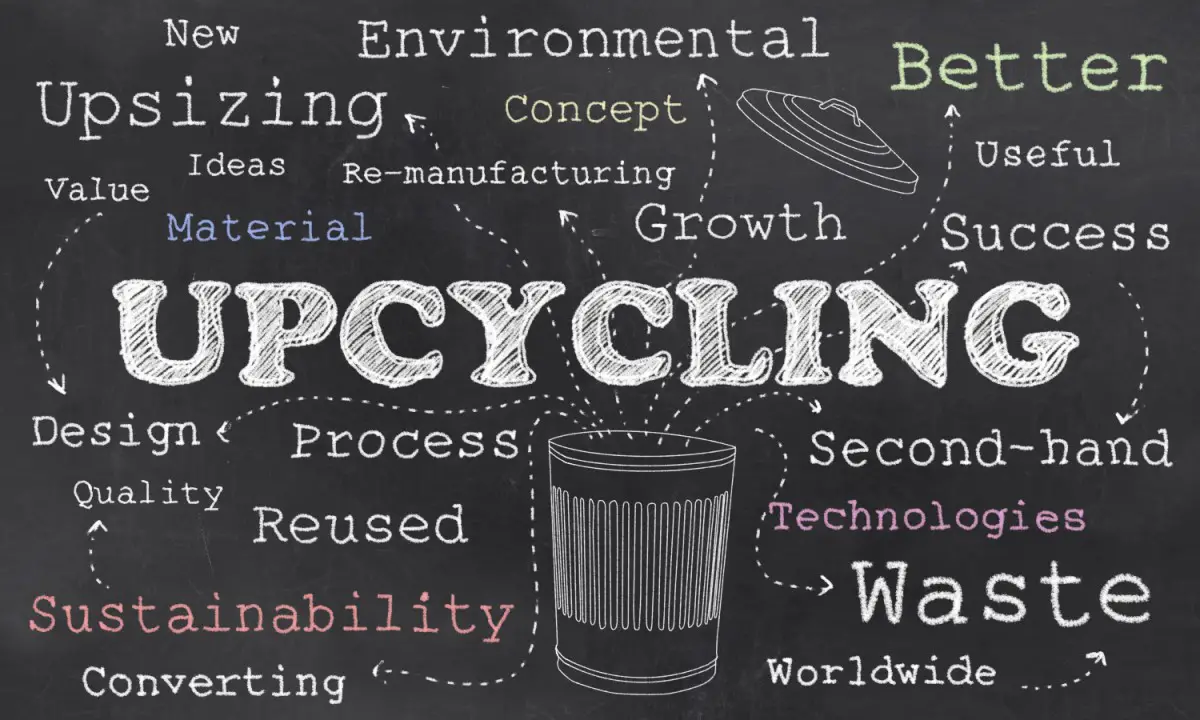Upcycling is the process of using old unwanted products or by-products to create new materials or new products that are purposeful and/or valuable. Upcycling is creating something new, useful, or artistic from something that is no longer in use.
Often, the term upcycling is used interchangeably with recycling, and it can be confusing, especially with the addition of the term downcycling. To clarify, utilizing items that would have been trashed or recycled to create something new that is perceived to be of greater quality, whether that is artistic value or monetary value, is upcycling.

Think of that gorgeous coffee table created from vintage suitcases or an old door being painted and repurposed into a stylish headboard. Upcycling is an environmentally friendly way to reduce waste and create items of value. Clothing and furniture items tend to be very popular upcycling items with so many upcycling projects on Pinterest, Instagram, Etsy, and other sites.
With a little creativity and DIY knowledge, you can find a new life for things from thrift stores, salvage yards, garage sales, or even on the curbs in your neighborhood. Or shop for a one-of-a-kind gift made from old, unwanted items instead of buying new.
What’s the Difference Between Upcycling, Downcycling, and Recycling?

The difference between upcycling and downcycling is in the end product. If the new product is deemed of higher value or quality, then it is upcycling; if it is of less value or quality, then it is referred to as downcycling. Both upcycling and downcycling are methods of recycling. Both repurpose items that would have been sent to landfills, upcycling to create items of improved purpose or value and downcycling to recycle items into a product that is of lower value than the original product.
Downcycling could mean turning old clothing and scrap linen into cleaning rags instead of trashing them or old plastic bottles being broken down and used to create carpet padding. Upcycling can be repurposing old tins or old teacups into high-end candles or turning old costume jewelry into new, on-trend accessories.
What is an Example of Upcycling?
Examples of upcycling include turning an old dresser into a garden planter. A bunch of scrapped t-shirts turned into a beautiful quilt or old wine corks assembled to create a useful corkboard.
The most popular categories for upcycling include furniture, clothes/textiles, home decor items, and jewelry. There are many ways to upcycle and turn trash into treasure. Furniture pieces that would otherwise be sent to the landfill can be refurbished. Empty containers that would be thrown in the trash can find new life with some paint and creativity. Empty containers can be repurposed into planters. With a bit of imagination and a creative hand, household items of all types can be reimagined into something of beauty and purpose. Below you will find a brief list of various examples of upcycling to get your creativity going.

There are lots of resources online for ideas on upcycling items in your house. The upcycling content online covers everything from paper products, glass, fabric, wood, plastic, and anything in between. Some are simple art and crafts ideas, while others may require some level of craftsmanship. Youtube is another great source of upcycling ideas and tutorials.
Upcycling Ideas
Your web browser is your greatest resource for ideas. An Etsy browse search will produce innumerable results for upcycling items. No matter what your personal sense of style or design aesthetic for your home is, you will find tips and ideas on how to upcycle and create a new treasure from that trash.
Furniture

- Refurbishing old furniture and giving it new life
- Old Suitcases as shelves or stacked as end tables
- Wooden ladder as a blanket ladder
- An old dresser used as an outdoor planter
- Old wooden window frames into chalkboards
- Wooden door into a bedframe
- Turning an old door into art or a decoration
- Reupholstering armchairs or loveseats
- Wood pallets into furniture
Household Goods

- Cotton Rounds from Scrap Fabric
- Old teacups into candles
- Candle jars into containers
- Old sweaters into pillow covers
- Vinyl Records into Decorative Clock
- Wine corkboard
- Painting glass bottles or jars
Fashion – Clothes and Textiles

- Old t-shirts into quilts
- Old fabric into scrunchies
- Adding fun patches to damaged clothes/jeans
- Turning old clothing into a tote bag
- Old jeans into skirts or shorts
- Dyeing an outdated or stained cocktail dress
- Transform old clothing into gift wrap
Industrial Upcycling
Industrial upcycling is a newer concept but a promising one. Companies such as Terracycle have embraced upcycling and created an entire industry. They have grown a business from taking hard-to-recycle items and creating new products from them. For example, food packaging that is impossible to recycle is now being collected and upcycled into things like park benches, coin purses, or pots for plants.
Other examples of industrial upcycling could include electronics. Think of refurbished iPhones and iPads, which are saved from destruction and continue to serve a purpose for those who purchase them. The end product, which is a working, functional personal electronic device, is of greater value than it was when it was headed to the landfill.
Another example is Asta, a company that has a vision for creating beautiful and useful items like purses, lighting, and bags from PET bottles. Upcycling plastic bottles, keeping them out of our landfills, and creating something of value for consumers is an admirable vision.
Is Upcycling Helping the Environment?
Upcycling helps our environment by decreasing waste and, in turn, the burden on our landfills. It reduces energy needs for producing new raw materials, which also means a reduction in air and water pollution. On a global level, it helps conserve resources and reduce greenhouse gas emissions.
Downcycling, upcycling, and recycling… Each method differs, but all have the same goal in mind. Each provides opportunities to help Planet Earth and do our part. Upcycling contributes to this goal with the reuse of items that would have been trashed. Reducing the burden on landfills and reducing the use of natural resources. This means a bigger impact on the health of our environment and an overall reduction in our carbon footprint.
Environmental Benefits
Reducing landfill waste – The best way to reduce landfill waste is to reduce consumption. We tend to over buy and purchase stuff we either don’t really need or could go without. However, we do, of course, need things now and then. Being a conscientious consumer means buying sustainable and green products whenever possible. This is very helpful, but you can take it to the next level by upcycling items that would have been trash. Keeping more out of our landfills is very good for the environment.
Minimizing Use of Natural Resources – Upcycling reduces the need for new materials and new products, which in turn reduces production needs. Manufacturing uses up an exorbitant amount of our precious natural resources such as water and fossil fuels, while also creating much of the pollution that is damaging our ozone layer. When we repurpose something we need or want, instead of buying a new product we are helping to decrease production needs. This helps ease the burden on non-renewable resources like coal, used in manufacturing.
Supporting Local Artistry – Buying local is economically helpful to your community, but its also benefical to the environment. Think about the environmental costs related to transporting goods. If you’re buying a refurbished table from a neighbor, or buying unique upcycled gifts from the woman at the local farmers market, you won’t be ordering them from half way across the country or the world. These items need to be shipped and transported, sometimes directly to your door, and this creates more pollution and consumption of fossil fuels.
Statistics
- Upcycling is estimated to reduce waste by up to 90% compared to traditional manufacturing processes.
- The global upcycling market is projected to reach USD 6.3 billion by 2026, growing at a CAGR of 8.2% from 2020 to 2026.
- The US upcycling market is projected to reach USD 1.8 billion by 2026, growing at a CAGR of 8.4% from 2020 to 2026.
- The UK upcycling market is projected to reach USD 0.4 billion by 2026, growing at a CAGR of 8.1% from 2020 to 2026.
- The Asia-Pacific upcycling market is projected to reach USD 2.3 billion by 2026, growing at a CAGR of 8.5% from 2020 to 2026.
The Future of Upcycling
The concept of upcycling has been embraced by the public. It seems it is a trend that is here to stay, and that’s great news considering the benefits to our environment. While some simply have one-time projects for their own homes, others have learned to make money through upcycling. If they’re crafty, creative, with knowledge of trends, they can create a business through upcycling.
There is a growing demand for sustainable, green products, and consumers are doing their research and asking questions about the products they purchase. Upcycling is a great opportunity to reduce the use of raw material and decrease the burden on our landfills. Companies are even taking note and creating products from recycled materials whenever possible. There is a growing number of companies whose entire business model is centered around creating products from what would otherwise be waste. The future of upcycling looks bright. It will be exciting to see what new innovations and ideas come from these businesses.

